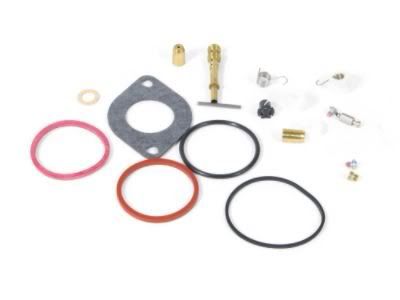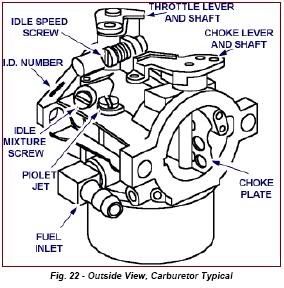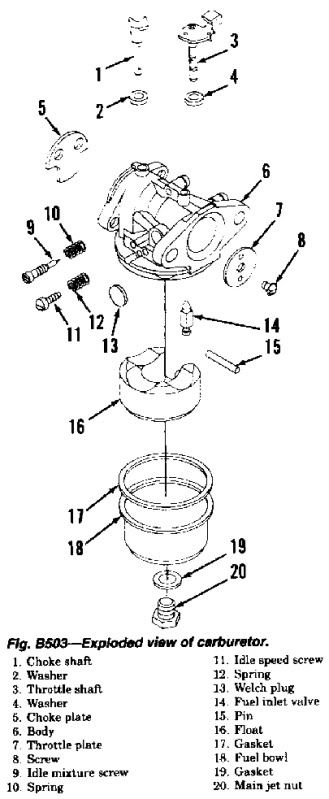Here's what I found.
If you're doing a rebuild, you'll need to purchase the repair kit for your carburetor, which includes replacement gaskets and other necessary parts. While you're at it, check the price of a complete replacement carburetor for your engine. In some cases, it may be more cost-effective to install a new one.
If you decide to rebuild, you will also need carburetor cleaner, a clean work surface and, ideally, a source of compressed air for blowing out loosened debris and solvent.
The design of your carburetor depends on the size of the engine and the application. Engines designed for lawn tractors require a precisely tuned carburetor with a choke and idle mixture system. Walk-behind mower engines operate well without these design enhancements. This section offers direction for cleaning and adjusting a range of carburetor types. Yours may look different and may require fewer steps.
Removing The Carburetor
Disconnect the spark plug lead and secure it away from the spark plug. Then, remove the air cleaner assembly (image A)
.
Turn off the fuel valve at the base of the fuel tank. If your engine does not contain a fuel valve, use a fuel line clamp to prevent fuel from draining out of the tank while the carburetor is disconnected from the engine (image B)
.
Some carburetors contain an electrical device at the base of the fuel bowl to control afterfire (image C)
. Disconnect the device, known as an anti-afterfire solenoid, by removing the wire connector from the solenoid's receptacle.
With the carburetor still connected to the governor, unfasten the carburetor mounting bolts. If a connecting pipe joins the carburetor to the engine block (image C)
, first remove the pipe mounting bolts. Then, disconnect the carburetor from the pipe by removing the nuts and sliding the carburetor off the studs.
Sketch the governor spring positions before disconnecting them (image D)
to simplify reattachment. Then, disconnect the governor springs and remove the carburetor, taking special care not to bend or stretch links, springs or control levers.
Disassembling A Float-Type Carburetor
Your carburetor contains a small amount of fuel. Prepare a clean bowl to catch dripping fuel and store small parts. During disassembly, inspect the bowl for dirt and debris to determine the condition of your carburetor.
Remove the fuel bowl from the carburetor body (image E)
. The fuel bowl may be attached with either a bolt or the high-speed mixture screw.
Push the hinge pin out of the carburetor body (image F)
with a small pin or pin punch. Take care to tap only the pin to avoid damaging the carburetor body.
Remove the float assembly, inlet needle valve and fuel bowl gasket (image G)
.
If your carburetor contains an idle mixture screw, remove it along with the spring (image A)
.
Rotate the throttle plate to the closed position, remove the throttle plate screws and the throttle plate (image B)
.
Remove the throttle plate shaft and foam seal (image C)
. Then, remove the choke plate and choke shaft and felt or foam washer in the same manner.
Use your carburetor repair kit to identify replaceable welch plugs (image D)
. These seals cover openings in the carburetor left over from machining. Insert a sharpened 5/32" pin punch at the edge of each plug to be removed and tap cleanly to free the plug.
Unscrew the main jet from the side of the carburetor pedestal (if equipped). Then, unscrew the emulsion tube; it may be screwed in tight. A carburetor screwdriver is the best tool for the job. It's designed to fit the slot in the head or the emulsion tube (image E)
so that you won't damage the threads inside the pedestal of the tube itself as you loosen it.
Remove the emulsion tube (image F)
.
Inspect The Carburetor
Soak metal and plastic carburetor parts in all-purpose parts cleaner for no more than 15 minutes to remove grit (image G)
. Or, wearing safety glasses, spray the parts with carburetor cleaner. Then, wipe away solvent and other residue thoroughly, using a clean cloth. Never use wire or tools. They can damage or further obstruct plugged openings.
Inspect all components and use additional carburetor cleaner to loosen stubborn grit and to clear obstructions.
Replace any parts that are damaged or permanently clogged.
Inspecting Mixture Screws
Brass mixture screws control the air-fuel mixture at high speed and at idle. Over tightening can damage the tip of the screw so that proper adjustment is no longer possible (image A)
. Remove any nonmetal parts and soak mixture screws in carburetor cleaner for 15 minutes. Then, inspect them carefully for wear. Replace a mixture screw if the tip is bent or contains a ridge.
Compensating For High Altitude
Small engines are set at the factory to operate at average atmospheric pressure. If you live at a high altitude, you may need to modify the carburetor to ensure adequate air or fuel intake. Depending on your model, you will need to remove the small metal fitting near the choke plate, known as the main jet air bleed (image B)
or replace the fixed main jet (image C)
with one designed for high elevations. Ask your Briggs & Stratton Authorized Dealer for additional details on the necessary adjustments for your area.
Reassembling The Carburetor
Install new welch plugs from your repair kit, using a pin punch slightly smaller than the outside diameter of the plug (image D)
. Tap on the punch with a hammer until the plug is flat (strong blows with the hammer will cause the plug to cave in). Then, seal the outside edge of the plug with enamel nail polish.
Assemble the choke by inserting the return spring inside the foam seal and sliding the spring and seal assembly onto the choke shaft. Plastic choke plates have a stop catch at one end of the spring; metal plates have a notch to hold the hook at one end of the spring.
Insert the choke shaft into the carburetor body and engage the return spring. If the choke lever uses a detent spring to control the choke plate position, guide the spring into the notched slot on the choke plate position, guide the spring into the notched slot on the choke lever. Place the choke plate on the shaft with the single notch on the edge toward the fuel inlet. Lift the choke shaft and lever up slightly and turn counterclockwise until the stop on the lever clears the spring anchor. Push the shaft down.
Insert the choke plate into the choke shaft or attach it with screws so that the dimples face the fuel inlet side of the carburetor. The dimples help hold and align the choke shaft and plate.
Install the throttle shaft seal with the sealing lip down in the carburetor body until the top of the seal is flush with the top of the carburetor. Turn the shaft until the flat side is facing out. Attach the throttle plate to the shaft with the screws so that the numbers on the throttle plate face the idle mixture screw and the dimples face in.
Install the inlet needle seat with the groove down, using a bushing driver. Then, install the inlet needle on the float and install the assembly in the carburetor body.
Insert the hinge pin and center pin. Then, install the rubber gasket on the carburetor and attach the fuel bowl, fiber washer and bowl nut.
Attaching The Carburetor And Air Cleaner Assembly
Position the carburetor so the beveled edge fits into the fuel intake pipe and attach the carburetor with nuts or bolts, as required (image E)
, leaving these fasteners loose for final tightening with a torque wrench. Consult your Briggs & Stratton Authorized Dealer for the proper tightening torque.
Install the air cleaner assembly, making certain that the tabs on the bottom of the air cleaner are engaged.
 this is what the rebuild kit consist of. Bought mine on eBay for about $25 shipped.
this is what the rebuild kit consist of. Bought mine on eBay for about $25 shipped.



If you're doing a rebuild, you'll need to purchase the repair kit for your carburetor, which includes replacement gaskets and other necessary parts. While you're at it, check the price of a complete replacement carburetor for your engine. In some cases, it may be more cost-effective to install a new one.
If you decide to rebuild, you will also need carburetor cleaner, a clean work surface and, ideally, a source of compressed air for blowing out loosened debris and solvent.
The design of your carburetor depends on the size of the engine and the application. Engines designed for lawn tractors require a precisely tuned carburetor with a choke and idle mixture system. Walk-behind mower engines operate well without these design enhancements. This section offers direction for cleaning and adjusting a range of carburetor types. Yours may look different and may require fewer steps.
Removing The Carburetor
Disconnect the spark plug lead and secure it away from the spark plug. Then, remove the air cleaner assembly (image A)
.
Turn off the fuel valve at the base of the fuel tank. If your engine does not contain a fuel valve, use a fuel line clamp to prevent fuel from draining out of the tank while the carburetor is disconnected from the engine (image B)
.
Some carburetors contain an electrical device at the base of the fuel bowl to control afterfire (image C)
. Disconnect the device, known as an anti-afterfire solenoid, by removing the wire connector from the solenoid's receptacle.
With the carburetor still connected to the governor, unfasten the carburetor mounting bolts. If a connecting pipe joins the carburetor to the engine block (image C)
, first remove the pipe mounting bolts. Then, disconnect the carburetor from the pipe by removing the nuts and sliding the carburetor off the studs.
Sketch the governor spring positions before disconnecting them (image D)
to simplify reattachment. Then, disconnect the governor springs and remove the carburetor, taking special care not to bend or stretch links, springs or control levers.
Disassembling A Float-Type Carburetor
Your carburetor contains a small amount of fuel. Prepare a clean bowl to catch dripping fuel and store small parts. During disassembly, inspect the bowl for dirt and debris to determine the condition of your carburetor.
Remove the fuel bowl from the carburetor body (image E)
. The fuel bowl may be attached with either a bolt or the high-speed mixture screw.
Push the hinge pin out of the carburetor body (image F)
with a small pin or pin punch. Take care to tap only the pin to avoid damaging the carburetor body.
Remove the float assembly, inlet needle valve and fuel bowl gasket (image G)
.
If your carburetor contains an idle mixture screw, remove it along with the spring (image A)
.
Rotate the throttle plate to the closed position, remove the throttle plate screws and the throttle plate (image B)
.
Remove the throttle plate shaft and foam seal (image C)
. Then, remove the choke plate and choke shaft and felt or foam washer in the same manner.
Use your carburetor repair kit to identify replaceable welch plugs (image D)
. These seals cover openings in the carburetor left over from machining. Insert a sharpened 5/32" pin punch at the edge of each plug to be removed and tap cleanly to free the plug.
Unscrew the main jet from the side of the carburetor pedestal (if equipped). Then, unscrew the emulsion tube; it may be screwed in tight. A carburetor screwdriver is the best tool for the job. It's designed to fit the slot in the head or the emulsion tube (image E)
so that you won't damage the threads inside the pedestal of the tube itself as you loosen it.
Remove the emulsion tube (image F)
.
Inspect The Carburetor
Soak metal and plastic carburetor parts in all-purpose parts cleaner for no more than 15 minutes to remove grit (image G)
. Or, wearing safety glasses, spray the parts with carburetor cleaner. Then, wipe away solvent and other residue thoroughly, using a clean cloth. Never use wire or tools. They can damage or further obstruct plugged openings.
Inspect all components and use additional carburetor cleaner to loosen stubborn grit and to clear obstructions.
Replace any parts that are damaged or permanently clogged.
Inspecting Mixture Screws
Brass mixture screws control the air-fuel mixture at high speed and at idle. Over tightening can damage the tip of the screw so that proper adjustment is no longer possible (image A)
. Remove any nonmetal parts and soak mixture screws in carburetor cleaner for 15 minutes. Then, inspect them carefully for wear. Replace a mixture screw if the tip is bent or contains a ridge.
Compensating For High Altitude
Small engines are set at the factory to operate at average atmospheric pressure. If you live at a high altitude, you may need to modify the carburetor to ensure adequate air or fuel intake. Depending on your model, you will need to remove the small metal fitting near the choke plate, known as the main jet air bleed (image B)
or replace the fixed main jet (image C)
with one designed for high elevations. Ask your Briggs & Stratton Authorized Dealer for additional details on the necessary adjustments for your area.
Reassembling The Carburetor
Install new welch plugs from your repair kit, using a pin punch slightly smaller than the outside diameter of the plug (image D)
. Tap on the punch with a hammer until the plug is flat (strong blows with the hammer will cause the plug to cave in). Then, seal the outside edge of the plug with enamel nail polish.
Assemble the choke by inserting the return spring inside the foam seal and sliding the spring and seal assembly onto the choke shaft. Plastic choke plates have a stop catch at one end of the spring; metal plates have a notch to hold the hook at one end of the spring.
Insert the choke shaft into the carburetor body and engage the return spring. If the choke lever uses a detent spring to control the choke plate position, guide the spring into the notched slot on the choke plate position, guide the spring into the notched slot on the choke lever. Place the choke plate on the shaft with the single notch on the edge toward the fuel inlet. Lift the choke shaft and lever up slightly and turn counterclockwise until the stop on the lever clears the spring anchor. Push the shaft down.
Insert the choke plate into the choke shaft or attach it with screws so that the dimples face the fuel inlet side of the carburetor. The dimples help hold and align the choke shaft and plate.
Install the throttle shaft seal with the sealing lip down in the carburetor body until the top of the seal is flush with the top of the carburetor. Turn the shaft until the flat side is facing out. Attach the throttle plate to the shaft with the screws so that the numbers on the throttle plate face the idle mixture screw and the dimples face in.
Install the inlet needle seat with the groove down, using a bushing driver. Then, install the inlet needle on the float and install the assembly in the carburetor body.
Insert the hinge pin and center pin. Then, install the rubber gasket on the carburetor and attach the fuel bowl, fiber washer and bowl nut.
Attaching The Carburetor And Air Cleaner Assembly
Position the carburetor so the beveled edge fits into the fuel intake pipe and attach the carburetor with nuts or bolts, as required (image E)
, leaving these fasteners loose for final tightening with a torque wrench. Consult your Briggs & Stratton Authorized Dealer for the proper tightening torque.
Install the air cleaner assembly, making certain that the tabs on the bottom of the air cleaner are engaged.




